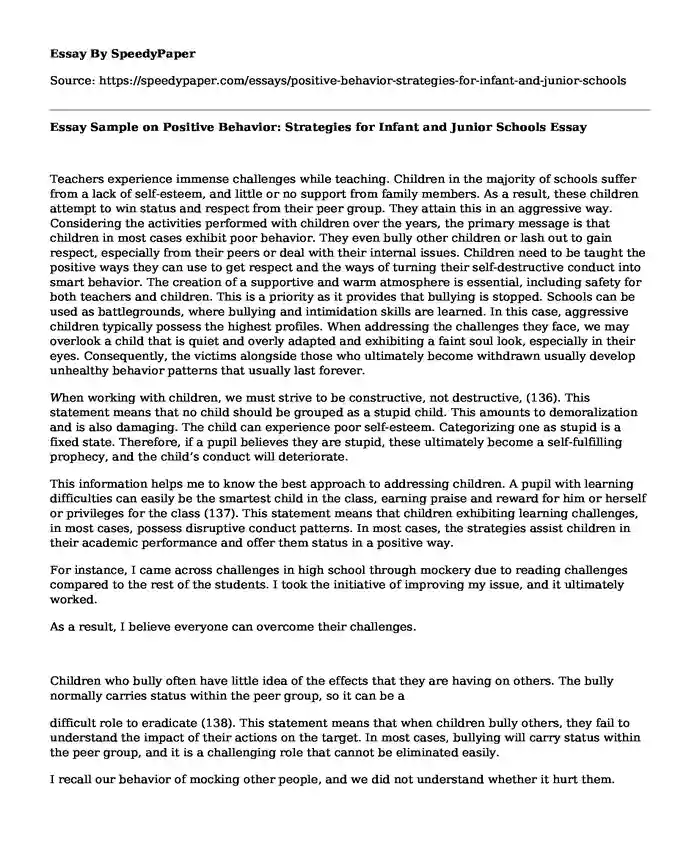
| Type of paper: | Essay |
| Categories: | Teaching Learning School Child development Human behavior |
| Pages: | 3 |
| Wordcount: | 666 words |
Teachers experience immense challenges while teaching. Children in the majority of schools suffer from a lack of self-esteem, and little or no support from family members. As a result, these children attempt to win status and respect from their peer group. They attain this in an aggressive way. Considering the activities performed with children over the years, the primary message is that children in most cases exhibit poor behavior. They even bully other children or lash out to gain respect, especially from their peers or deal with their internal issues. Children need to be taught the positive ways they can use to get respect and the ways of turning their self-destructive conduct into smart behavior. The creation of a supportive and warm atmosphere is essential, including safety for both teachers and children. This is a priority as it provides that bullying is stopped. Schools can be used as battlegrounds, where bullying and intimidation skills are learned. In this case, aggressive children typically possess the highest profiles. When addressing the challenges they face, we may overlook a child that is quiet and overly adapted and exhibiting a faint soul look, especially in their eyes. Consequently, the victims alongside those who ultimately become withdrawn usually develop unhealthy behavior patterns that usually last forever.
When working with children, we must strive to be constructive, not destructive, (136). This statement means that no child should be grouped as a stupid child. This amounts to demoralization and is also damaging. The child can experience poor self-esteem. Categorizing one as stupid is a fixed state. Therefore, if a pupil believes they are stupid, these ultimately become a self-fulfilling prophecy, and the child’s conduct will deteriorate.
This information helps me to know the best approach to addressing children. A pupil with learning difficulties can easily be the smartest child in the class, earning praise and reward for him or herself or privileges for the class (137). This statement means that children exhibiting learning challenges, in most cases, possess disruptive conduct patterns. In most cases, the strategies assist children in their academic performance and offer them status in a positive way.
For instance, I came across challenges in high school through mockery due to reading challenges compared to the rest of the students. I took the initiative of improving my issue, and it ultimately worked.
As a result, I believe everyone can overcome their challenges.
Children who bully often have little idea of the effects that they are having on others. The bully normally carries status within the peer group, so it can be a
difficult role to eradicate (138). This statement means that when children bully others, they fail to understand the impact of their actions on the target. In most cases, bullying will carry status within the peer group, and it is a challenging role that cannot be eliminated easily.
I recall our behavior of mocking other people, and we did not understand whether it hurt them.
Feelings of rage erupt like mini volcanoes. Unchecked, these tendencies grow until we have aggressive adolescents and adults (140). The statement focuses on the hurting instances that children make on one another by biting, kicking, and hitting. The behaviors need to be controlled in advance to avoid transfer to later ages in life.
This information allows an understanding of the way feelings emerge among children. I can understand how children develop bullying conduct.
Action Section
Taking into consideration the activities performed with children over the years, the primary message is that children in most cases exhibit poor behavior. Children need to be taught the positive ways they can use to get respect and the ways of turning their self-destructive conduct into a smart behavior. The creation of a supportive and warm atmosphere is essential, including safety for both teachers and children. This is a priority as it provides that bullying is stopped.
References
Halbert, E. (2002). Positive behavior: Strategies for infant and junior schools. Bullying: A Practical Guide to Coping for Schools, 135-153 http://www.academia.edu/download/34213531/libro_Bullying-Michele-Elliott.pdf page. 148
Cite this page
Essay Sample on Positive Behavior: Strategies for Infant and Junior Schools. (2023, Aug 06). Retrieved from https://speedypaper.net/essays/positive-behavior-strategies-for-infant-and-junior-schools
Request Removal
If you are the original author of this essay and no longer wish to have it published on the SpeedyPaper website, please click below to request its removal:
- Paper Example on Nature of Writing
- Research Paper on Strategies for Academic Success
- Free Essay Example - Applied Public Relations
- Compare and Contrast Paper on The Theories of Piaget and Vygotsky
- Paper Example. Online Learning is Less Satisfactory than Face-To-Face
- Paper Example: Students Should Return to School During the COVID-19 Pandemic
- Essay Sample: Reflection on Culture
Popular categories




